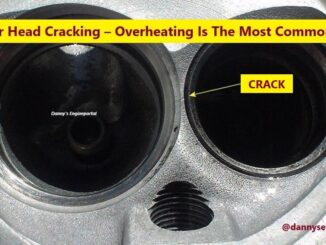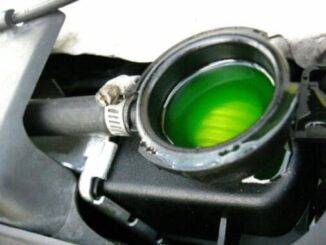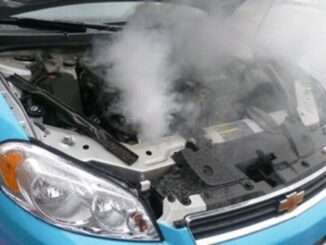
Today the radiator cap, is more important than ever before.
However, it is often missed, as being a cause of engine overheating.
So, a radiator cap looks simple, but is critical, for a properly operating cooling system. Because, a faulty radiator cap, can result in engine overheating, loss of coolant or major engine damage.
Above all, never open a radiator cap, until the engine has cooled down.
So, pressurized cooling systems, help prevent overheating and coolant loss. Also, they raise the coolants boiling point, about 3-degrees F for each additional (psi), above atmospheric pressure.
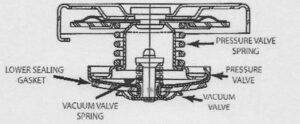
As the engine warms up and the coolant expands, it becomes pressurized.. The caps pressure relief valve, allows pressure to build up to a set level, then lets excess pressure escape.
Older Vehicle (Open) Systems

In an (open) system found in older vehicles, excess pressure escapes to the atmosphere through an overflow tube. As air enters through the overflow tube, coolant will be lost.
Newer Vehicle (Closed) Systems
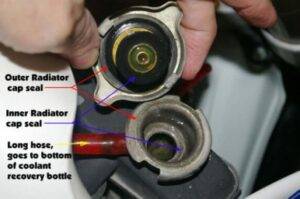
Here, as the coolant expands, it goes through the overflow tube, into a recovery tank. The cap now serves, as a vacuum relief and siphon valve. As the engine is cooling, the coolant also contracts. As a result, allowing it to be siphoned, back into the radiator.
High Pressure / Radiator Cap
So, radiator caps, also serve as pressure relief valves. Because, they will prevent excessive pressure. Unchecked high pressure, could cause damage to the radiator, heater core, hoses or water pump seal. The pressure cap, also prevents radiator hoses and tanks from collapsing. As the engine cools, it causes a vacuum in the cooling system. This vacuum draws the coolant, back in the system, instead of air.

Always check the cap, during routine maintenance. Never remove the cap, when the engine is hot. With the engine off, place a rag over the cap. Turn it counterclockwise, about 1/4-turn, until it reaches the safety stop. Allow all pressure to vent, before removing the cap. Then, press down and turning it counter-clockwise.
Common Failure Symptoms, Of A Radiator Cap
There are a few signs that will let you know, if you have a faulty cap:
Leaking Coolant
If the radiator cap is stuck, fluid cannot get released. This will cause pressure, to build inside the radiator, causing hoses to leak or break open. If you notice coolant, near the radiator or the radiator cap, then you clearly have leaking coolant. Check to see if the radiator has holes in it or if the cap looks, worn or damaged. If so, then replace the cap.
Recovery Tank (Reservoir, Overflow, Expansion)
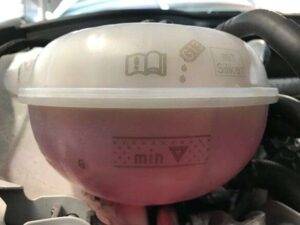
Coolant goes into the recovery tank, as it expands. The cap is released, by the pressure and the coolant is sent, toward the recovery tank. If you have a bad cap, the coolant will get released, too fast. And, cause the recovery tank to boil over.
Radiator Hose Collapses
You may have a bad cap, if the radiator hose collapses. The vacuum won’t be released properly and will cause the radiator hose, to collapse, during the cooling period. If this happens, inspect the cap, to see if there is any damage. If there is, replace it immediately.
Air Inside The Cooling System
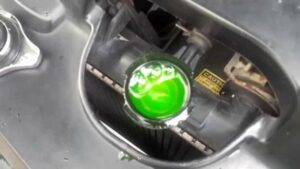
When your cap does not seal properly, air will get inside the cooling system. This will cause air pockets, to get inside the heater core, thermostat, and radiator hoses. As a result, the engine will start to overheat. Because, it cannot sustain the proper temperature.
Overheated Engine
So, leaky coolant or air in the cooling system, can lead to an overheated engine. If you notice your engine getting too hot, don’t look under the hood. Let it cool down first. That way, the engine can remain cool, as you check it out. If there is coolant near the radiator cap, there could be damage to the cap. Check for that and replace as needed.
Conclusion
Since radiator caps are so important and are relatively inexpensive, why not just replace it with a new one.

Also, inspect the recovery tube, that joins the filler neck to the recovery tank. Consequently, to see if its loose, cracked or is blocked. Check the radiator filler neck sealing surfaces for nicks, dents or corrosion, that could impair sealing. Inspect gaskets, to see if they are loose or cracked. Consequently, that could allow pressure leakage and coolant to escape. Finally, make sure you are using, the correct mixture of fluids.
Thank You !


